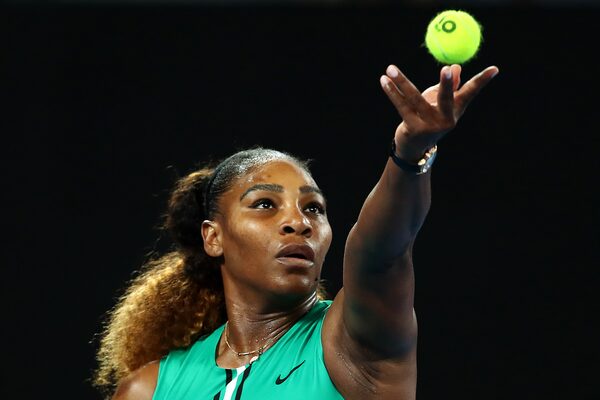
Serena Williams serves during her second round match against Eugene Bouchard during day four of the 2019 Australian Open at Melbourne Park on Jan. 17, 2019 in Melbourne, Australia.Cameron Spencer/Getty Images
After 170th-ranked Christopher Eubanks made it through the qualifying draw of a Grand Slam event for the first time last week, many of his friends from back in Atlanta began to grasp how far his career had come.
It was not because of the three qualifying matches he had won, but rather because of who joined him for a practice before the Australian Open began: Serena Williams.
“Some of my friends who don’t really know tennis were saying, ‘If he’s hitting with Serena, he must be pretty good,’” Eubanks said.
His session with her was part of a new strategy for Williams, who is training with some of the best current players from the men’s tour to raise the intensity of her practices. In addition to Eubanks, Williams has practiced this month with No. 15 Stefanos Tsitsipas, No. 21 Grigor Dimitrov, No. 39 Frances Tiafoe and No. 88 Bernard Tomic.
Asked about her practices with such players, Williams said simply, “It was fun,” but her coach, Patrick Mouratoglou, was more loquacious.
“If she lifts her level on a daily basis that much, she’s going to improve incredibly,” he said.
The early returns from the strategy have been positive: Williams beat Eugenie Bouchard, 6-2, 6-2, in the second round Thursday night, thwarting the resurgent Canadian with sharp, focused aggression. Williams was particularly strong on her return, winning 61 per cent of points on Bouchard’s serve.
Mouratoglou said the shift to finding the best male opposition available was “a long-term plan,” not a temporary trend.
“I think that it’s very important in your practice to be challenged, because I think that she can become much better than what she is already,” Mouratoglou said. “But in order to become better, if you’re not challenged, you have no chance. I thought that to be challenged at practice was a good idea, so we tried once and we really loved it.”
That first try, Mouratoglou said, was with Australian player Thanasi Kokkinakis last year at Mouratoglou’s academy in France.
“She said: ‘Wow, it was great, great rhythm, and it’s tough. It pushes me,’” Mouratoglou said. “I thought she played incredible.”
Kokkinakis, who had beaten Roger Federer earlier that spring at the Miami Open, shared that assessment, marvelling at his inability to push Williams back from her position on the baseline even with his hardest, heaviest shots.
“She’s so, so strong on the ball,” he said. “When I thought I hit some good shots that even some male players might even struggle with, she took it on the rise, handled it pretty well.”
Williams has practised with men throughout her career, usually employing a man as a full-time hitting partner. Most have been years removed from their active days on tour and had achieved modest rankings. Her long-time hitting partner Sascha Bajin peaked at 1,149th; his successor, Robbye Poole, reached 414th; her current hitting partner, Jarmere Jenkins, reached a high of 190th.
Other top men and women have shared practice courts in the first month of the tennis season. Andy Murray and Naomi Osaka, for example, hit together for 30 minutes at a tournament in Brisbane, Australia.
Mouratoglou said that he emphasized to the men that they should not treat Williams differently from any other practice partner.
He said he told Eubanks, “Play for yourself – it’s your practice.”
Eubanks said the session with Williams helped him in his first-round loss Monday against 19th-seeded Nikoloz Basilashvili. Eubanks had set points to go up by two sets to one on a player ranked 150 spots ahead of him.
“Serena hits, in my opinion, one of the cleanest balls in the history of tennis,” Eubanks said. “I was working on absorbing pace, because she puts enough pace on it that you’re really working the legs. I’m being as professional as I can, because you’re on the court with Serena Williams. You don’t want her to think you can’t play.”
Eubanks said he felt the effects of Williams’s intensity and skill the rest of the day.
“I practised again in the evening and I told my coach I felt like I did a lift today, because my quads are so sore from just hitting with her for an hour,” he said.
After Williams’s victory over Bouchard, on-court interviewer Jim Courier joked that she should charge the men she hits with for lessons. Indeed, many of Williams’s past practice partners have been thriving in Melbourne: Tsitsipas, Tiafoe and Alexei Popyrin have reached the third round at the Open for the first time.
“Just to hit with a legend, especially Serena, it really gave me a great, great experience,” Popyrin said after No. 7 Dominic Thiem retired from their second-round match on Thursday. “She gave me some tips after the hit, so it was great.”
Tiafoe, whom Williams hit with several times while they were teammates at the Hopman Cup, had his best career victory on Wednesday when he beat fifth-seeded Kevin Anderson in the second round.
Tiafoe said he had difficulty handling Williams’s zipping shots, as he was more used to the spinning shots male players tend to use.
“I was struggling,” Tiafoe said of hitting with Williams. “She hits the ball so hard. The courts are fast; it was skidding. I mean, a little topspin, maybe? I’m not used to the ball coming in that flat. That was something I really had to adjust to.”
Mouratoglou said no man had turned down an offer to hit with Williams.
“And I don’t think any will say no,” he said. “It’s a great experience for them, too, and I think they’re curious how Serena is hitting, for real.”